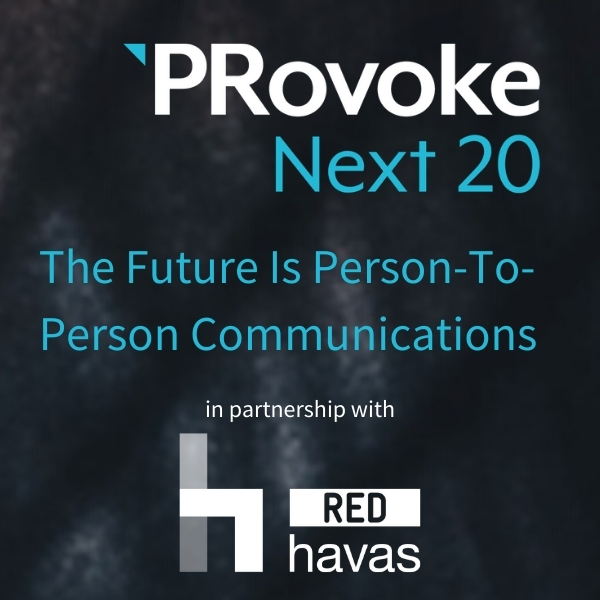Mark Henricks 28 Oct 2020 // 3:45PM GMT

Of all 2020’s many unprecedented developments, perhaps one of the least expected is the way corporate communications has emerged as a critical channel for transmitting reliable, helpful information to people and organizations. With political leadership in many cases fragmented, lacking or wrong-headed, and the credibility of government agencies and the media under assault, brands serving both consumers and other businesses have become trusted sources for guidance.
“Business has taken a front seat in communicating what we should do about the pandemic and how businesses should operate in lieu of consistent political leadership,” says James Wright, global chief executive officer of Red Havas. Wright notes how corporate CEOs, more than political leaders, have consistently voiced recommendations to wear masks, wash hands and social distance.
The fact that they got the part doesn’t mean American brands in particular are well-suited for it, given skillsets focused on a profit-centric, transaction-oriented approach. People have picked up on this. Red Havas’ “Meaningful Brands” survey found 84 percent of people think brands should communicate honestly about commitments and promises – but just 38 percent think businesses do. In other words, brands have a credibility issue — despite that — their leadership is needed.
Today, with necessity forcing them invent, communicators are inventing a more human-oriented approach. At its center — people talking to people. The way this is playing out in the B2B, especially during the pandemic, points to this being more than a passing fancy.
“This is an opportunity,” says Jeffrey Whitford, head of sustainability, social business innovation and life science branding at MilliporeSigma. As a key player in producing COVID therapeutics and vaccines, MilliporeSigma felt a responsibility to inject a respect for data into communications.
“We do need trusted sources of information that hopefully can steer clear of politicizing this type of information,” Whitford adds. “It’s important to have good quality information so people can make good decisions for the benefit of their families and trust the organizations that are making decisions.”
Sitting the pandemic out may not be an option, according to the 2020 Global Communication Report from USC’s Annenberg School, which surveyed PR professionals and found 84 percent agreed brands should take a stand on social issues relevant to their businesses, which respondents most commonly cited diversity and inclusion in this realm.
And, if anything, the future looks like more of the same, since most of younger PR workers wanted brands to engage on issues outside their comfort zone.
While person-to-person communications has been percolating for years, the pandemic has accelerated its widespread adoption. In part, this is because so many people are working from home now, says Wright.
“What working from home has done for everybody is you’ve opened up your lives,” he says. “Your personal lives and work lives have become blurred. It’s no longer working from home. Your home is your work. When I’m talking with executives, I’m meeting them in their homes. I’m meeting their children. I’m meeting their dogs. I’m seeing their interior decorating and bad hair days.” Under those circumstances, a demeanor fit for an office or conference room seems unnatural.
What’s happening is actually an extension of earlier trends, observes Pattie Sullivan, Red Havas senior vice president and practice head for B2B. “Even prior to the pandemic, lines between work and personal lives were blurring,” Sullivan notes. “Everybody’s been checking email later and later in the evening. With everybody under lockdown for weeks or months, that line has been pretty much erased. And the way we interact personally and professionally has changed.”
Another change uplifting P2P in B2B has been the halt to most travel and in-person events, says Katie Holden, head of brand and content at automated ID verification and authentication provider AU10TIX. Cancelling elbow-rubs like SXSW is no minor matter, she says. “It’s in those intimate moments that you get things done,” Holden says. “People need to figure out another way to make those connections. There’s a huge void, and P2P helps fill that void.”
For some brands, going P2P is more necessity than option, says Davitha Ghiassi, Red Havas executive vice president for social and integration. “Look at the airline industry, for example, and the amount of trust they’ve had to regain with people to get on a plane,” Ghiassi says. She points to Delta, in particular, for uncharacteristically personal messages emphasizing the Delta CareStandard for keeping business and consumer travelers safe.
“Since the start of the pandemic they’ve been super transparent in terms of what Covid means to their customers,” Ghiassi says of the airline. “It started to echo across all their channels. You’d see it on Facebook and Instagram with personal announcements that you wouldn’t have seen before.”
For Ghiassi, it’s time for communicators at businesses that sell to other businesses to jettison the terminology along with the old ways. “We need to stop calling it B2B,” she says. “You’re not talking to a business. You’re talking to a person. You need to call it P2P.”
B2B communicators who have been around a while will notice P2P resembles established practices like word-of-mouth marketing. But while there are similarities, the rules of engagement include some notable differences. Maybe the biggest is the need to have and to show purpose in communications.
This is not your pre-pandemic purpose, Wright cautions. “Over the last decade, we’ve been talking about brands having a purpose beyond profit,” he says. “That’s all very well until a thing like this happens. Then it suddenly gets pressure-tested. It’s under such scrutiny now. Do you have a purpose other than profit? Are you going to go straight to protecting shareholders or are you going to protect your stakeholders?”
This shift may not be something to try to wait out until coronavirus ebbs. “Those organizations that that stayed true to their purpose will set themselves up for greater success,” Wright says. Decisions made today will go down in history as to how that brand will be viewed in the medium and long-term.”
Another P2P development is the importance of employee-generated content. This variation on user-generated content helps brands ramp up authenticity while cost-effectively adding a strong personal element to B2B communications. Whitford at MilliporeSigma is all over this one.
“There are a lot of studies that show when I share something to my network it’s much more engaged with versus when a company shares that information,” Whitford says. Companies can enable and encourage employees to share personal communications in a B2B environment by several methods, including creating a pool of shareable content workers can pick and choose from. Communicators can also sift employee-created content for desirable messages they can be encouraged to share.
The other area with different rules is partnering. Of course, partnering with other companies has long been part of B2B, and partnering with high-profile influencers is a B2C staple. But with person-to-person, B2B partners don’t need to be other corporations. They can also include influencers.
“Consumer brands can look at mega-influencers, people who are household names, have TV shows named after them and millions of people follow them,” Sullivan says. “For B2B it makes sense to have a targeted effort. You want influences who may not have as many followers – micro- or nano-influencers, they call them. But they are the ones your customers will make connections with. This is important for authenticity.”
And don’t write off experiential marketing and events. B2B has always been driven by relationship marketing and communications, often delivered in person at expos, roundtables and the like, notes Zach Barkus, lead consumer health marketer from cloud-based health benefits platform WEX Health. Relationships are still going to be paramount, but they will happen online rather than face-to-face.
“The events of this year, specifically the pandemic, have forced many brands in B2B to evolve and adapt,” Barkus says. “That’s especially true about finding new ways to engage customers they might have previously engaged in person through a sales channel or marketing event. Now we’re having to engage digitally or virtually.”
Personalizing B2B goes past communications. Product design, packaging and customer experience can also speak P2P. “People expect things to be personalized,” Ghiassi says. “That’s what makes a brand meaningful. Not personalizing your brand and your communications puts you at a disadvantage.”
Sullivan suggests looking at the brand experience holistically and searching broadly for opportunities to reach customers. “P2P is beyond communications,” she says. “It has to be integrated into all the touch points that you audience is going to have. It’s the product. It’s the website. You want that no matter how your customer experiences your product.”
Person-to-person communication in B2B is no panacea or something-for-nothing promise. For instance, encouraging employee-generated communications boosts authenticity but limits control. “It can be the wild, wild West,” Whitford acknowledges. “You can get yourself in situations your legal department won’t love. So you have to build understanding within your community and employee base about expectations.”
“Authenticity is really important,” Ghiassi stresses. “Make sure whatever you’re echoing in communications strategy actually aligns with the company’s value and purpose and you have a consistent message from employees and executives. If you have confusing or conflicting messaging it can become inauthentic. It needs to come from a place of truth.”
Another key: tailor personalization to the channel. A message that works great in the learning-oriented environment of LinkedIn will likely fall flat in the Instagram’s entertainment-minded world, Ghiassi warns. “Knowing what your customer expects from the channel is important,” she says.
One thing many customers want these days is some sense of stability, which gives rise to another P2B B2B rule from Barkus. “Maybe now more than ever, cadence and routine go a long way,” he says. “Establishing a familiarity with how and when you’re going to communicate your message with your customer is extremely important, and that’s especially true now that days and nights are mismatched.”
This can be as simple as creating a regular schedule for touching base and sticking to it. Avoid, for instance, sending a monthly newsletter the first week of one month and the second or third week the next month. “If that newsletter goes out the first Monday of the month you want to make sure it’s always the first Monday of the month,” Barkus advises. “You want that cadence so you can build other communications around it.”
Finally, don’t take personalized communication too far. Be sensitive to tone and keep on the business-like side. “P2P does not mean BFF,” Holden says. “These are personal relations but they remain professional in the B2B space. You’re not talking to your best friend from home. You’re still trying to make a professional connection.”
As unclear as the post-COVID future may be, Wright urges business leaders to keep their focus there, and even to go farther out than they might have in the past. He calls it the grandchild policy. “Is this a decision you’re making for the short term,” he asks, “or is this a decision that will make your business strong over the next 20 years and is it a decision you’ll look back on in 20 years and be proud?”
That’s inarguably putting a more human face on B2B communications than has been par. But in the context of COVID and beyond that’s how it’s going to be, Wright says. “It’s shaped everybody’s thinking in a very different way,” he says. “Only history will say whether some of these brands will continue this way in a post-pandemic word. But I do believe there’s been a fundamental shift in how people think about selling.”


































.jpg)


















